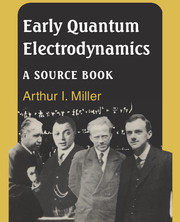Book contents
- Frontmatter
- Contents
- Preface
- Notes to the Preface
- Acknowledgements
- Notes to the Reader
- I Frame-setting essay
- Epilogue
- Notes
- References to the Frame-setting essay
- II Selected papers
- 1 The self-energy of the electron
- 2 Remarks on radiation theory
- 3 Theory of the positron
- 4 Discussion of the infinite distribution of electrons in the theory of the positron
- 5 The self-energy of the electron
- 6 Remarks on the Dirac theory of the positron
- 7 The quantization of the scalar relativistic wave equation
- 8 The electrodynamics of the vacuum based on the quantum theory of the electron
- 9 Theory of the emission of long-wave light quanta
- 10 The universal length appearing in the theory of elementary particles
- 11 The interaction between charged particles and the radiation field
- Index to Frame-setting essay
5 - The self-energy of the electron
Published online by Cambridge University Press: 05 August 2012
- Frontmatter
- Contents
- Preface
- Notes to the Preface
- Acknowledgements
- Notes to the Reader
- I Frame-setting essay
- Epilogue
- Notes
- References to the Frame-setting essay
- II Selected papers
- 1 The self-energy of the electron
- 2 Remarks on radiation theory
- 3 Theory of the positron
- 4 Discussion of the infinite distribution of electrons in the theory of the positron
- 5 The self-energy of the electron
- 6 Remarks on the Dirac theory of the positron
- 7 The quantization of the scalar relativistic wave equation
- 8 The electrodynamics of the vacuum based on the quantum theory of the electron
- 9 Theory of the emission of long-wave light quanta
- 10 The universal length appearing in the theory of elementary particles
- 11 The interaction between charged particles and the radiation field
- Index to Frame-setting essay
Summary
Zeitschrift für Physik, 89: 27–39 (1934). Received 13 March 1934.
The self-energy of the electron is derived in a closer formal connection with classical radiation theory, and the self-energy of an electron is calculated when the negative energy states are occupied, corresponding to the conception of positive and negative electrons in the Dirac ‘hole’ theory. As expected, the self energy also diverges in this theory, and specifically to the same extent as in ordinary single-electron theory.
Problem definition
The self-energy of the electron is the energy of the electromagnetic field which is generated by the electron in addition to the energy of the interaction of the electron with this field. Waller, Oppenheimer, and Rosenfeld calculated the self-energy of the free electron by means of the Dirac relativistic wave equation of the electron and the Dirac theory of the interaction between matter and light. They here used an approximation method which represents the self-energy in powers of the charge e. They found that the first term, which is proportional to e2, already becomes infinitely large. The essential reason for this is that the theory of the interaction of the electron with the electromagnetic field is built on the classical equations of motion of a point shaped electron whose self-energy, as is well known, also becomes infinite in classical theory.
In the present note, the expressions for the self-energy shall be derived without direct application of quantum electrodynamics, but by means of the Heisenberg radiation theory, which is linked much more closely to classical electrodynamics.
- Type
- Chapter
- Information
- Early Quantum ElectrodynamicsA Sourcebook, pp. 157 - 168Publisher: Cambridge University PressPrint publication year: 1994



